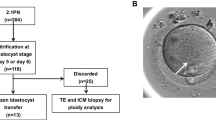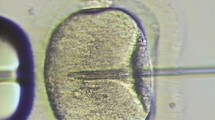Abstract
Purpose
The purpose of this study is to determine the profile of extracellular microRNAs (exmiRNAs) in follicular fluid (FF) and explore their association with fertilization potential and embryo quality.
Methods
We collected FF from single follicles containing mature oocytes from 40 women undergoing IVF and we screened for the expression of 754 exmiRNAs in FF using the TaqMan OpenArray® qPCR platform. To determine the association of exmiRNAs and IVF outcomes, we compared their expression levels in FF samples that differ by fertilization status (normally, abnormally, and failed to fertilize) and embryo quality (top vs. non-top).
Results
We detected 207 exmiRNAs, of which miR-30d-5p, miR-320b, miR-10b-3p, miR-1291, and miR-720 were most prevalent. We identified four exmiRNAs with significant fold change (FC) when FF that contained normally fertilized was compared to failed to fertilize oocytes [miR-202-5p (FC = 1.82, p = 0.01), miR-206 (FC = 2.09, p = 0.04), miR-16-1-3p (FC = 1.88, p = 0.05), and miR-1244 (FC = 2.72, p = 0.05)]. We also found four exmiRNAs to be significantly differentially expressed in FF that yielded top quality versus non-top quality embryos [(miR-766-3p (FC = 1.95, p = 0.01), miR-663b (FC = 0.18, p = 0.02), miR-132-3p (FC = 2.45, p = 0.05), and miR-16-5p (FC = 3.80, p = 0.05)]. In-silico analysis revealed that several of these exmiRNAs are involved in pathways implicated in reproductive system diseases, organismal abnormalities, and organ development.
Conclusions
Our findings suggest that exmiRNAs in the follicular fluid can lead to downstream events that will affect fertilization and day 3 embryo morphology. We encourage further observational and experimental studies to confirm our findings and to determine the role of exmiRNAs in human reproduction.


Similar content being viewed by others
References
Eppig JJ. Oocyte control of ovarian follicular development and function in mammals. Reproduction. 2001;122(6):829–38.
Eppig JJ, Chesnel F, Hirao Y, O’Brien MJ, Pendola FL, Watanabe S, et al. Oocyte control of granulosa cell development: how and why. Hum Reprod. 1997;12(11 Suppl):127–32.
Buccione R, Schroeder AC, Eppig JJ. Interactions between somatic cells and germ cells throughout mammalian oogenesis. Biol Reprod. 1990;43(4):543–7.
Kidder GM, Vanderhyden BC. Bidirectional communication between oocytes and follicle cells: ensuring oocyte developmental competence. Can J Physiol Pharmacol. 2010;88(4):399–413. doi:10.1139/y10-009.
Winterhager E, Kidder GM. Gap junction connexins in female reproductive organs: implications for women’s reproductive health. Hum Reprod Update. 2015. doi:10.1093/humupd/dmv007.
Matzuk MM, Burns KH, Viveiros MM, Eppig JJ. Intercellular communication in the mammalian ovary: oocytes carry the conversation. Science. 2002;296(5576):2178–80. doi:10.1126/science.1071965.
Yanez-Mo M, Siljander PR, Andreu Z, Zavec AB, Borras FE, Buzas EI, et al. Biological properties of extracellular vesicles and their physiological functions. J Extracellular Vesicles. 2015;4:27066. doi:10.3402/jev.v4.27066.
Da Silveira JC, Sessions DR, Veeramachaneni DNR, Winger QA, Carnevale EM, Bouma GJ. MiRNAs within the ovarian follicle: Identification of cell-secreted vesicles as miRNA carriers. Biol Reprod. 2011;85(1).
Raposo G, Stoorvogel W. Extracellular vesicles: exosomes, microvesicles, and friends. J Cell Biol. 2013;200(4):373–83. doi:10.1083/jcb.201211138.
Zhang M, Ouyang H, Xia G. The signal pathway of gonadotrophins-induced mammalian oocyte meiotic resumption. Mol Hum Reprod. 2009;15(7):399–409. doi:10.1093/molehr/gap031.
Machtinger R, Laurent LC, Baccarelli AA. Extracellular vesicles: roles in gamete maturation, fertilization and embryo implantation. Hum Reprod Update. 2016;22(2):182–93. doi:10.1093/humupd/dmv055.
Bartel DP. MicroRNAs: genomics, biogenesis, mechanism, and function. Cell. 2004;116(2):281–97.
Lim LP, Lau NC, Garrett-Engele P, Grimson A, Schelter JM, Castle J, et al. Microarray analysis shows that some microRNAs downregulate large numbers of target mRNAs. Nature. 2005;433(7027):769–73. doi:10.1038/nature03315.
Li SC, Tang P, Lin WC. Intronic microRNA: discovery and biological implications. DNA Cell Biol. 2007;26(4):195–207. doi:10.1089/dna.2006.0558.
Krol J, Loedige I, Filipowicz W. The widespread regulation of microRNA biogenesis, function and decay. Nat Rev Genet. 2010;11(9):597–610. doi:10.1038/nrg2843.
Nagaraja AK, Andreu-Vieyra C, Franco HL, Ma L, Chen R, Han DY, et al. Deletion of Dicer in somatic cells of the female reproductive tract causes sterility. Mol Endocrinol. 2008;22(10):2336–52. doi:10.1210/me.2008-0142.
Saetrom P, Snove Jr O, Rossi JJ. Epigenetics and microRNAs. Pediatr Res. 2007;61(5 Pt 2):17R–23R. doi:10.1203/pdr.0b013e318045760e.
Santonocito M, Vento M, Guglielmino MR, Battaglia R, Wahlgren J, Ragusa M, et al. Molecular characterization of exosomes and their microRNA cargo in human follicular fluid: bioinformatic analysis reveals that exosomal microRNAs control pathways involved in follicular maturation. Fertil Steril. 2014;102(6):1751–U590. doi:10.1016/j.fertnstert.2014.08.005.
da Silveira JC, de Andrade GM, Nogueira MF, Meirelles FV, Perecin F. Involvement of miRNAs and cell-secreted vesicles in mammalian ovarian antral follicle development. Reprod Sci. 2015;22(12):1474–83. doi:10.1177/1933719115574344.
Navakanitworakul R, Hung WT, Gunewardena S, Davis JS, Chotigeat W, Christenson LK. Characterization and small RNA content of extracellular vesicles in follicular fluid of developing bovine antral follicles. Sci Rep. 2016;6:25486. doi:10.1038/srep25486.
da Silveira JC, Winger QA, Bouma GJ, Carnevale EM. Effects of age on follicular fluid exosomal microRNAs and granulosa cell transforming growth factor-beta signalling during follicle development in the mare. Reprod Fertil Dev. 2015;27(6):897–905. doi:10.1071/RD14452.
Sohel Md. Mahmodul H, Hoelker M, Noferesti SS, Salilew-Wondim D, Tholen E, Looft C et al. Exosomal and non-exosomal transport of extra-cellular microRNAs in follicular fluid: Implications for bovine oocyte developmental competence. PloS one. 2013;8(11).
da Silveira JC, Veeramachaneni DNR, Winger QA, Carnevale EM, Bouma GJ. Cell-secreted vesicles in equine ovarian follicular fluid contain mirnas and proteins: A possible new form of cell communication within the ovarian follicle. Biology of Reproduction. 2012;86(3).
Kim YJ, Ku SY, Kim YY, Liu HC, Chi SW, Kim SH, et al. MicroRNAs transfected into granulosa cells may regulate oocyte meiotic competence during in vitro maturation of mouse follicles. Hum Reprod. 2013;28(11):3050–61. doi:10.1093/humrep/det338.
Machtinger R, Bormann CL, Ginsburg ES, Racowsky C. Is the presence of a non-cleaved embryo on day 3 associated with poorer quality of the remaining embryos in the cohort? J Assist Reprod Genet. 2015. doi:10.1007/s10815-015-0455-9.
Alpha Scientists in Reproductive M, Embryology ESIGo. The Istanbul consensus workshop on embryo assessment: proceedings of an expert meeting. Hum Reprod. 2011;26(6):1270–83. doi:10.1093/humrep/der037.
Enderle D, Spiel A, Coticchia CM, Berghoff E, Mueller R, Schlumpberger M, et al. Characterization of RNA from exosomes and other extracellular vesicles isolated by a novel spin column-based method. PLoS One. 2015;10(8):e0136133. doi:10.1371/journal.pone.0136133.
Racowsky C, Combelles CM, Nureddin A, Pan Y, Finn A, Miles L, et al. Day 3 and day 5 morphological predictors of embryo viability. Reprod Biomed Online. 2003;6(3):323–31.
Machtinger R, Racowsky C. Morphological systems of human embryo assessment and clinical evidence. Reprod Biomed Online. 2013;26(3):210–21. doi:10.1016/j.rbmo.2012.10.021.
Mestdagh P, Van Vlierberghe P, De Weer A, Muth D, Westermann F, Speleman F, et al. A novel and universal method for microRNA RT-qPCR data normalization. Genome Biol. 2009;10(6):R64. doi:10.1186/gb-2009-10-6-r64.
Livak KJ, Schmittgen TD. Analysis of relative gene expression data using real-time quantitative PCR and the 2(-Delta Delta C(T)) Method. Methods. 2001;25(4):402–8. doi:10.1006/meth.2001.1262.
Agarwal V, Bell GW, Nam JW, Bartel DP. Predicting effective microRNA target sites in mammalian mRNAs. eLife. 2015;4. doi:10.7554/eLife.05005.
Assou S, Al-edani T, Haouzi D, Philippe N, Lecellier CH, Piquemal D, et al. MicroRNAs: new candidates for the regulation of the human cumulus-oocyte complex. Hum Reprod. 2013;28(11):3038–49. doi:10.1093/humrep/det321.
Liu FJ, Shen XF. Comparative analysis of human reproductive proteomes identifies candidate proteins of sperm maturation. Mol Biol Rep. 2012;39(12):10257–63. doi:10.1007/s11033-012-1902-7.
Sang Q, Yao Z, Wang H, Feng R, Wang H, Zhao X, et al. Identification of MicroRNAs in human follicular fluid: characterization of MicroRNAs that govern steroidogenesis in vitro and are associated with polycystic ovary syndrome in vivo. J Clin Endocrinol Metab. 2013;98(7):3068–79.
Moreno JM, Nunez MJ, Quinonero A, Martinez S, de la Orden M, Simon C, et al. Follicular fluid and mural granulosa cells microRNA profiles vary in in vitro fertilization patients depending on their age and oocyte maturation stage. Fertil Steril. 2015;104(4):1037–46. doi:10.1016/j.fertnstert.2015.07.001. e1.
Velthut-Meikas A, Simm J, Tuuri T, Tapanainen JS, Metsis M, Salumets A. Research resource: small RNA-seq of human granulosa cells reveals miRNAs in FSHR and aromatase genes. Mol Endocrinol. 2013;27(7):1128–41. doi:10.1210/me.2013-1058.
Kishimoto T. Cell-cycle control during meiotic maturation. Curr Opin Cell Biol. 2003;15(6):654–63.
Stitzel ML, Seydoux G. Regulation of the oocyte-to-zygote transition. Science. 2007;316(5823):407–8. doi:10.1126/science.1138236.
Schier AF. The maternal-zygotic transition: death and birth of RNAs. Science. 2007;316(5823):406–7. doi:10.1126/science.1140693.
Giraldez AJ, Mishima Y, Rihel J, Grocock RJ, Van Dongen S, Inoue K, et al. Zebrafish MiR-430 promotes deadenylation and clearance of maternal mRNAs. Science. 2006;312(5770):75–9. doi:10.1126/science.1122689.
Whitaker M. Calcium at fertilization and in early development. Physiol Rev. 2006;86(1):25–88. doi:10.1152/physrev.00023.2005.
Machaty Z. Signal transduction in mammalian oocytes during fertilization. Cell Tissue Res. 2016;363(1):169–83. doi:10.1007/s00441-015-2291-8.
Schatten H, Sun QY. New insights into the role of centrosomes in mammalian fertilization and implications for ART. Reproduction. 2011;142(6):793–801. doi:10.1530/REP-11-0261.
Mihaylova MM, Shaw RJ. The AMPK signalling pathway coordinates cell growth, autophagy and metabolism. Nat Cell Biol. 2011;13(9):1016–23. doi:10.1038/ncb2329.
Cargnello M, Roux PP. Activation and function of the MAPKs and their substrates, the MAPK-activated protein kinases. Microbiol Mol Biol Rev : MMBR. 2011;75(1):50–83. doi:10.1128/MMBR.00031-10.
Odile ML, Heloise C, Julia M, Robert B, Patrick C. MAPK/ERK activity is required for the successful progression of mitosis in sea urchin embryos. Dev Biol. 2016. doi:10.1016/j.ydbio.2016.11.018.
Feng R, Sang Q, Zhu Y, Fu W, Liu M, Xu Y, et al. MiRNA-320 in the human follicular fluid is associated with embryo quality in vivo and affects mouse embryonic development in vitro. Sci Rep. 2015;5:8689. doi:10.1038/srep08689.
Kropp J, Khatib H. Characterization of microRNA in bovine in vitro culture media associated with embryo quality and development. J Dairy Sci. 2015;98(9):6552–63. doi:10.3168/jds.2015-9510.
Armstrong DA, Green BB, Seigne JD, Schned AR, Marsit CJ. MicroRNA molecular profiling from matched tumor and bio-fluids in bladder cancer. Mol Cancer. 2015;14:194. doi:10.1186/s12943-015-0466-2.
Cha DJ, Franklin JL, Dou Y, Liu Q, Higginbotham JN, Demory Beckler M, et al. KRAS-dependent sorting of miRNA to exosomes. eLife. 2015;4:e07197. doi:10.7554/eLife.07197.
Guzman N, Agarwal K, Asthagiri D, Yu L, Saji M, Ringel MD, et al. Breast cancer-specific miR signature unique to extracellular vesicles includes “microRNA-like” tRNA fragments. Mol Cancer Res : MCR. 2015;13(5):891–901. doi:10.1158/1541-7786.MCR-14-0533.
Joshi GK, Deitz-McElyea S, Liyanage T, Lawrence K, Mali S, Sardar R, et al. Label-free nanoplasmonic-based short noncoding RNA sensing at attomolar concentrations allows for quantitative and highly specific assay of MicroRNA-10b in biological fluids and circulating exosomes. ACS Nano. 2015;9(11):11075–89. doi:10.1021/acsnano.5b04527.
Melman YF, Shah R, Danielson K, Xiao J, Simonson B, Barth A, et al. Circulating MicroRNA-30d is associated with response to cardiac resynchronization therapy in heart failure and regulates cardiomyocyte apoptosis: a translational pilot study. Circulation. 2015;131(25):2202–16. doi:10.1161/CIRCULATIONAHA.114.013220.
Acknowledgements
We thank the patients that donated the follicular fluid and the IVF team contributing to this study.
Author information
Authors and Affiliations
Corresponding author
Ethics declarations
Funding
This study was funded by Grant Award no. RPGA1301 from the Environmental and Health Fund (EHF), Israel and by grants P30ES00002 and R21ES024236 from the National Institute of Environmental Health Sciences, USA.
Additional information
Ronit Machtinger and Rodosthenis S. Rodosthenous contributed equally to this work.
Rights and permissions
About this article
Cite this article
Machtinger, R., Rodosthenous, R.S., Adir, M. et al. Extracellular microRNAs in follicular fluid and their potential association with oocyte fertilization and embryo quality: an exploratory study. J Assist Reprod Genet 34, 525–533 (2017). https://doi.org/10.1007/s10815-017-0876-8
Received:
Accepted:
Published:
Issue Date:
DOI: https://doi.org/10.1007/s10815-017-0876-8




